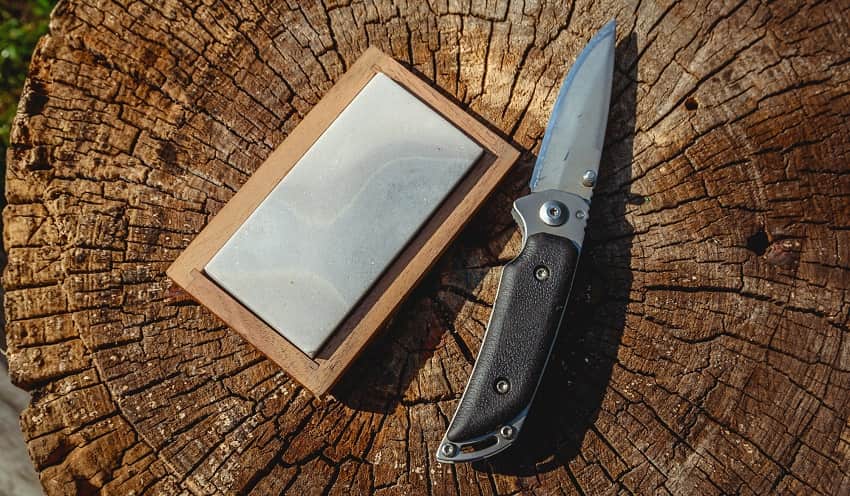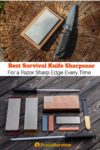[ad_1]
Your knife is one of your most important and versatile survival tools. But as the old saying goes, “a dull knife is more dangerous than a sharp one”.
Why?
A dull knife is less effective and more likely to slip, so it carries a greater risk of you cutting yourself. And if there’s one thing you don’t want in a survival situation, it’s a deep cut that can easily get infected.
In this article, we’ve rounded up the best knife sharpeners to sharpen your tools at home and retain that edge when you’re out and about.
Knife Sharpener Reviews
Top Pick
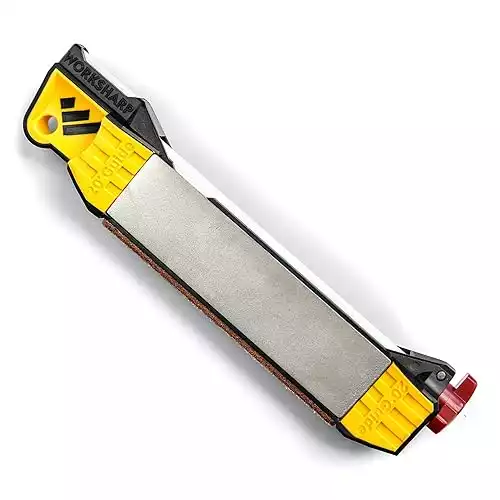

Work Sharp Guided Field Sharpener
The Work Sharp is a portable sharpener that can be used to sharpen small knives, serrated blades, hatchets and fish hooks.
There are three different sharpening surfaces plus a leather strop to polish off any burrs, making it one of the most versatile sharpeners portable enough to add to your Bug Out Bag.
The small size does mean that there’s not much of the base unit to hold onto when sharpening. There’s more risk of you cutting yourself than with the Spyderco Tri-Angle, so treat it with caution!
There’s also no carry case to protect it, so it’s worth buying or making your own for a couple of bucks – or just wrap it in a piece of cloth.
The diamond plates are replaceable and put a really sharp edge on a blade. Because of the design, you may struggle to sharpen large knives, but it’s perfect for assisted opening knives and other EDC tools.
Dimensions:
6.8 x 1.3 in
Weight:
4.8 oz
Material:
Coarse + fine diamond plates, ceramic rod, leather strop
- Versatile
- Portable
- Great value
- Replaceable plates
- No carry case
- Not much to hold onto when sharpening
Beginners Pick
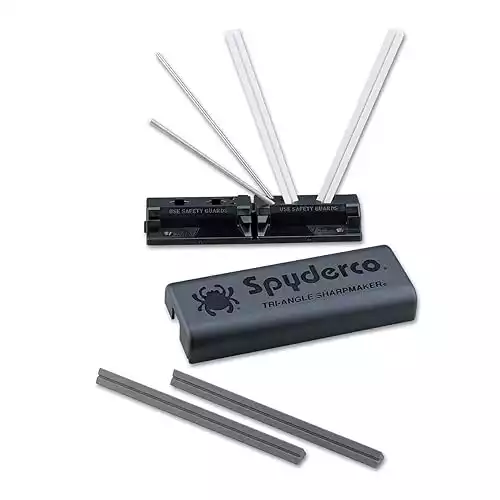

Spyderco Sharpmaker
If you’re put off the idea of sharpening your knives for fear of getting it wrong, then the Spyderco Sharpmaker is your new best friend.
Not only is it easy to use, but there’s a detailed instruction guide and DVD included.
The kit comes with two medium-grit ceramic rods and two fine ceramic rods. There are also a couple of safety rods to protect your hands while sharpening.
Keyed holes in the base allow you to set the correct angle for sharpening and as the rods are triangular, you can use them to sharpen serrated blades.
The ceramic rods will be good enough for touch-ups and light sharpening, but if you have a premium steel blade or you want to do some serious re-profiling, you’ll need the diamond steel rod, which you can buy separately.
The main downside is that ceramic rods are breakable – not ideal for a survival situation. They do pack into the plastic base case, which offers some protection (and makes the unit compact and easy to pack); just don’t go throwing them around.
Dimensions:
7.5 x 3.0 in
Weight:
1 lb 4.5 oz
Material:
Fine + medium ceramic
- Can be used for most serrated blades as well as straight blades
- Easy to use
- Long-lasting
- Good safety features
- Harder steels will need the diamond rod (sold separately)
- Plastic case feels a little cheap
- Ceramic rods are breakable
Best for Pocket Knives
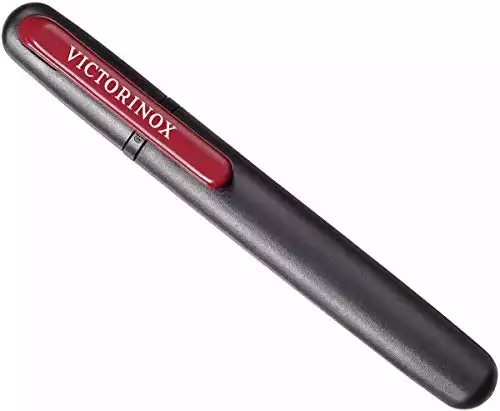

Victorinox Pocket Knife Sharpener
The Victorinox 4.3323 sharpener features a honing stone and ceramic notch in a lightweight package that’s not much bigger than a large pen.
If you’ve never sharpened a knife before, you may find this tool takes a bit of getting used to. But once you’ve mastered the art of sharpening, you’ll find it quick and easy to keep your blades sharp (as long as you don’t let them get too dull!).
Although the Victorinox 4.3323 excels when it comes to portability, as an all-around sharpener, it’s not perfect. The sharpening stone is a medium grit that will give you a usable sharp edge but not a razor edge, and the ceramic discs are a bit too small to do much other than polish up an already sharp blade.
However, for the price and – more importantly – portability, the Victorinox sharpener would be a good addition to your Bug Out Bag.
Dimensions:
9 in.
Weight:
1.4 oz
Material:
Ceramic discs and stone
- Lightweight and portable
- Great value
- Durable
- Takes some skill to use properly
- A little small for larger blades
Budget Pick
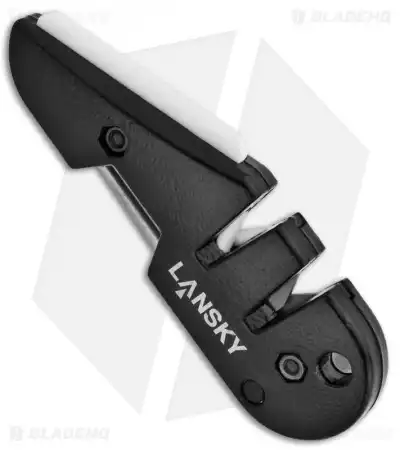

Lansky Tactical Blademedic
Knife enthusiasts can get a bit snobby about pull-through sharpeners.
Yes, they don’t have the precision of a sharpening stone, yes, they only work for one angle, and yes, they may be a bit rough on your precious blades, but they do have some advantages.
Number one is that anyone can use them – you don’t have to have spent ten years honing your skills to put a sharp edge on your knife. They also tend to be relatively small and low-cost.
The Lansky Tactical Blademedic is a super lightweight sharpener that won’t take up much space in your pack. Although it’s inexpensive, it has a solid metal construction, so it will be more durable than the plastic alternatives.
There’s a tungsten carbide slot for dull blades, ceramic sharpening rods, a ceramic bar for serrated knives, and a tapered diamond rod. It won’t get your knife as sharp as using a whetstone, but it’s a handy tool to maintain an edge and for emergency use.
Dimensions:
8.25 x 4.5 x 3.75 in.
Weight:
0.25 oz
Material:
Tungsten carbide, ceramic + diamond rod
- Very compact and lightweight
- Robust and well made
- Great value
- Best to maintain an edge rather than sharpen from scratch
Best Whetstone
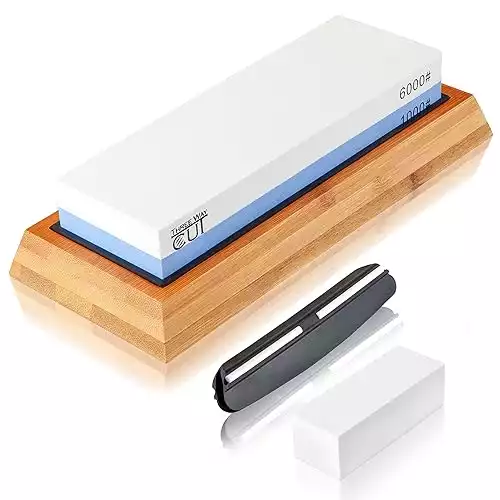

Knife Sharpening Stone Kit
The best way of making sure your knives are ready to use in an emergency is to always keep them sharp. This whetstone is too heavy for your Bug Out Bag, but you can use it to keep your blades honed to a razor-sharp edge.
Begin by soaking the stone in water for 5-10 minutes. Use the coarse 1000-grit side of the block for re-profiling or sharpening up dull knives, then switch to the fine-grained side for a final polish.
The whetstone comes with an angle guide, but it’s not that helpful – you’re better off watching a bunch of YouTube videos to learn how to properly sharpen a knife.
The stone is set into a rubber-bottomed bamboo base, so you don’t have to hold it down while you’re sharpening, and it’s big enough to sharpen blades of different lengths.
It can only really be used for straight knives (if you have a serrated blade, the Spyderco is a better option), but unlike most portable sharpeners, you can use the stone to turn a very dull or chipped blade into a sharp survival knife.
Dimensions:
7.3 x 2.3 in.
Weight:
2 lb 3 oz
Material:
Aluminium oxide
- Double-sided design
- Can be used for different sized blades
- Durable
Things to Consider
As a prepper, your knife sharpening system may involve more than one sharpener. You may have a whetstone or a set of ceramic rods (such as the Spyderco Sharpmaker Tri-Angle) at home, plus a small, lightweight tool to keep those edges sharp when in the field.
A good knife sharpening kit will include the following:
A Range of Abrasive Surfaces
Abrasiveness is measured in grit. The higher the number, the finer the grain. You’ll want a coarse grit surface to work on very hard or dull blades, plus a fine grit to hone a perfect edge.
Safety Features
It sounds obvious, but playing with knives carries a risk of getting hurt.
Some sharpeners are designed to protect your hand; others can be clamped down or are heavy enough to stay put for two-handed sharpening.
While a small, lightweight sharpener is good for portability, it may be harder to use safely than a more heavyweight model.
Angle Guide
If you’re new to knife sharpening, an angle guide can help you hold the blade at the correct angle.
You’ll want one you can adjust for different angles and is sturdy enough to properly guide your movements.
A weak angle guide can be worse than not using one at all!
Leather Strop
Stropping is the final stage of sharpening a knife. It removes any slight imperfections or burrs and polishes the blade to a shine. A piece of leather is a perfect tool for this.
Oversharpening Your Knife
Be careful when using these tools, as it is actually possible to damage your knife if you over-sharpen it. See this guide – can you oversharpen a knife?
Conclusion
You can spend a fortune on a high-quality knife, but if you don’t keep it sharp, it’ll be of little use to you in a survival situation.
You don’t have to spend hours learning about angles and grains of stone to keep your blades sharp. With a bit of care, any of the sharpeners we’ve covered in this article will do a good job.
And if the SHTF and you don’t have your trusty knife sharpener to hand, make sure you’re prepared by checking out our guide to alternative ways you can sharpen your knife in an emergency.
[ad_2]
Source link
